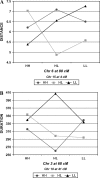An epistatic genetic basis for physical activity traits in mice
- PMID: 18534999
- PMCID: PMC2574643
- DOI: 10.1093/jhered/esn045
An epistatic genetic basis for physical activity traits in mice
Abstract
We recently identified several (4-8) quantitative trait loci (QTL) for 3 physical activity traits (daily distance, duration, and speed voluntarily run) in an F(2) population of mice derived from an original intercross of 2 strains that exhibited large differences in activity. These QTL cumulatively explained from 11% to 34% of the variation in these traits, but this was considerably less than their total genetic variability estimated from differences among inbred strains. We therefore decided to test whether epistatic interactions might account for additional genetic variation in these traits in this same population of mice. We conducted a full genome epistasis scan for all possible interactions of QTL between each pair of 20 chromosomes. The results of this scan revealed an abundance of epistasis, with QTL throughout the genome being involved in significant interactions. Overall, epistatic effects contributed an average of 26% of the total variation among the 3 activity traits. These results suggest that epistatic interactions of genes may play as important a role in the genetic architecture of physical activity traits as single-locus effects and need to be considered in future candidate gene identification studies.
Figures
References
-
- Blair SN, LaMonte MJ, Nichman MZ. The evolution of physical activity recommendations: how much is enough? Am J Clin Nutr. 2004;79:913S–920S. - PubMed
-
- Chakravarthy M, Booth F. Eating, exercise, and “thrift” genotypes: connecting the dots toward an evolutionary understanding of modern chronic diseases. J Appl Physiol. 2004;96:3–10. - PubMed
-
- Cheverud JM. Detecting epistasis among quantitative trait loci. In: Wolf J, Brodie E II, Wade M, editors. Epistasis and the evolutionary process. New York: Oxford University Press; 2000. pp. 58–81.
-
- Cheverud JM. A simple correction for multiple comparisons in interval mapping genome scans. Heredity. 2001;87:52–58. - PubMed
-
- Cheverud JM, Routman EJ, Irschick DK. Pleiotropic effects of individual gene loci on mandibular morphology. Evolution. 1997;51:2004–2014. - PubMed
Publication types
MeSH terms
Grants and funding
LinkOut - more resources
Full Text Sources
Miscellaneous


